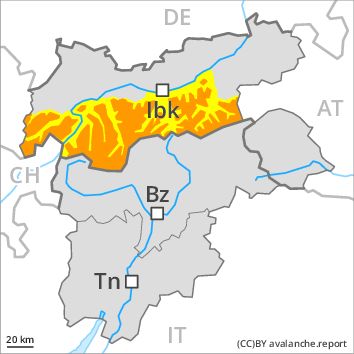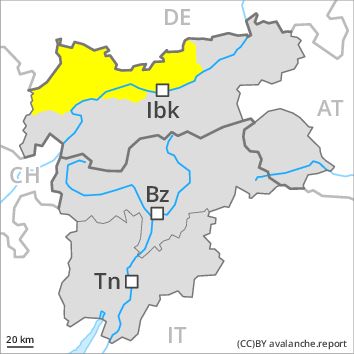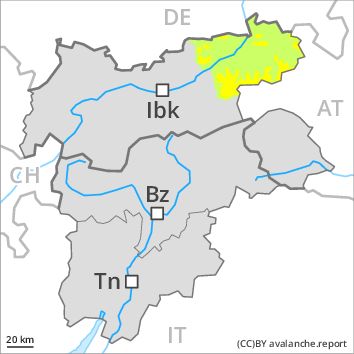Regions
Western Tuxer Alps, Eastern Tuxer Alps, Glockturm Range, Weißkugel Range, Western Verwall Mountains, Gurgler Range, Central Stubai Alps, Eastern Verwall Mountains, Northern Zillertal Alps, Silvretta, Samnaun Mountains, Northern Oetz and Stubai Alps

Danger level
Danger Level 3 - Considerable above 2400m
Danger Level 2 - Moderate above 2400m
Avalanche Problem
Wind-drifted snow above 2400m, NE-E-SE-S-SW-W
Gliding snow above 2600m, E-SE-S-SW-W

Wind slabs require caution.
Fresh and somewhat older wind slabs are to be assessed with care and prudence. Caution is to be exercised adjacent to ridgelines as well as in gullies and bowls, and behind abrupt changes in the terrain in particular above approximately 2400 m. Single snow sport participants can release avalanches as before, including medium-sized ones.
Dry avalanches can additionally be released in deeper layers, mostly by large additional loads. This applies in particular on steep south facing slopes above approximately 2600 m as well as on steep east and west facing slopes above approximately 2400 m. In particular transitions from a shallow to a deep snowpack are unfavourable.
Small to medium-sized gliding avalanches are possible. This applies in particular on steep grassy slopes, especially on east, south and west facing slopes below approximately 2600 m, but in isolated cases also on steep shady slopes below approximately 2000 m.
Snowpack
dp 6: cold, loose snow and wind
dp 2: gliding snow
The wind will be moderate in some regions. In particular adjacent to ridgelines the wind slabs will increase in size moderately. In some cases the wind slabs have bonded still only poorly together, in particular at high altitudes and in high Alpine regions. Faceted weak layers exist in the old snowpack in particular in areas where the snow cover is rather shallow. This applies in particular adjacent to ridgelines as well as on steep east, south and west facing slopes at high altitudes and in high Alpine regions.
Tendency
Further decrease in danger of dry avalanches. Slight increase in danger of gliding avalanches.
Regions
Sexten Dolomites, Val Müstair Alps, Langtaufers, Schnals Ridge, Southern Stubai Alps, Southern Zillertal Alps and High Tauern, Saldurn-Mastaun Ridge, Texel Mountains, Sarntal Alps, Western Pfunderer Mountains, Eastern Pfunderer Mountains, Durreck Range, Western Rieserferner Mountains, Western Deferegger Alps, Ortler Range, Ulten Valley, Venediger Range, Eastern Nonsberger Alps, Eastern Rieserferner Mountains, Northern Dolomites of Fiemme, Glockner Range, Gröden Dolomites, Eastern Deferegger Alps, Prags Dolomites, Schober Mountains, Lienzer Dolomites

Danger level
Danger Level 3 - Considerable above 2200m
Danger Level 2 - Moderate above 2200m
Avalanche Problem
Wind-drifted snow above 2200m, N-NE-E-SE-S-SW-W-NW
Gliding snow above 2600m, N-NE-E-SE-S-SW-W-NW

The fresh wind slabs represent the main danger.
Fresh and somewhat older wind slabs must be evaluated with care and prudence in all aspects above approximately 2200 m. Avalanches can be released by a single winter sport participant and reach large size in isolated cases. The wind slabs are to be found in particular adjacent to ridgelines and in gullies and bowls. In isolated cases avalanches can be triggered in deep layers of the snowpack and reach quite a large size. The number and size of avalanche prone locations will increase with altitude.
Especially below approximately 2600 m small and medium-sized gliding avalanches and moist snow slides are possible. Areas with glide cracks are to be avoided. The current avalanche situation calls for extensive experience in the assessment of avalanche danger and restraint.
Snowpack
dp 6: cold, loose snow and wind
dp 2: gliding snow
In some cases the various wind slabs have bonded still only poorly with each other and the old snowpack. Faceted weak layers exist in the old snowpack, in particular on steep, rather lightly snow-covered east, south and west facing slopes as well as adjacent to ridgelines above approximately 2200 m.
Tendency
Further decrease in danger of dry avalanches. In addition a latent danger of gliding avalanches and moist snow slides exists.
Regions
Karwendel Mountains, Western Lechtal Alps, Central Lechtal Alps, Grieskogel Mountains, Allgäu Alps, Eastern Lechtal Alps - Ammergau Alps, Mieming Mountains

Danger level
Danger Level 2 - Moderate
Avalanche Problem
Wind-drifted snow above 2400m, NE-E-SE-S-SW-W
Gliding snow above 2600m, E-SE-S-SW-W

Wind slabs in particular on near-ridge slopes.
Fresh and older wind slabs are to be evaluated with care and prudence above approximately 2200 m. The avalanche prone locations are to be found in particular adjacent to ridgelines. The avalanche prone locations are clearly recognisable to the trained eye. Avalanches can in isolated cases be released by small loads and reach medium size. The wind slabs are to be bypassed in particular in very steep terrain.
Especially below approximately 2600 m small and medium-sized gliding avalanches and moist snow slides are possible. Areas with glide cracks are to be avoided.
Snowpack
dp 6: cold, loose snow and wind
dp 2: gliding snow
In some cases the various wind slabs have bonded still only poorly together, in particular adjacent to ridgelines. The snowpack will become increasingly stable. This applies in particular at low and intermediate altitudes.
Tendency
Gradual decrease in danger of dry avalanches. Slight increase in danger of gliding avalanches.
Regions
Brandenberg Alps, Western Kitzbühel Alps, Wilder Kaiser Mountains - Waidring Alps, Eastern Kitzbühel Alps

Danger level
Danger Level 2 - Moderate above the treeline
Danger Level 1 - Low above the treeline
Avalanche Problem
Wind-drifted snow above the treeline, NE-E-SE-S-SW-W
Gliding snow above 2400m, E-SE-S-SW-W

Wind slabs in particular on near-ridge slopes.
The fresh wind slabs are to be evaluated with care and prudence above the tree line. The avalanche prone locations are to be found in particular adjacent to ridgelines. The avalanche prone locations are clearly recognisable to the trained eye. Avalanches can in isolated cases be released by small loads and reach medium size. The wind slabs are to be bypassed in particular in very steep terrain.
Especially below approximately 2400 m small and medium-sized gliding avalanches and moist snow slides are possible. Areas with glide cracks are to be avoided.
Snowpack
dp 6: cold, loose snow and wind
dp 2: gliding snow
In some cases the various wind slabs have bonded still only poorly together, in particular adjacent to ridgelines. The snowpack will become increasingly stable. This applies in particular at low and intermediate altitudes.
Tendency
Gradual decrease in danger of dry avalanches. Slight increase in danger of gliding avalanches.




